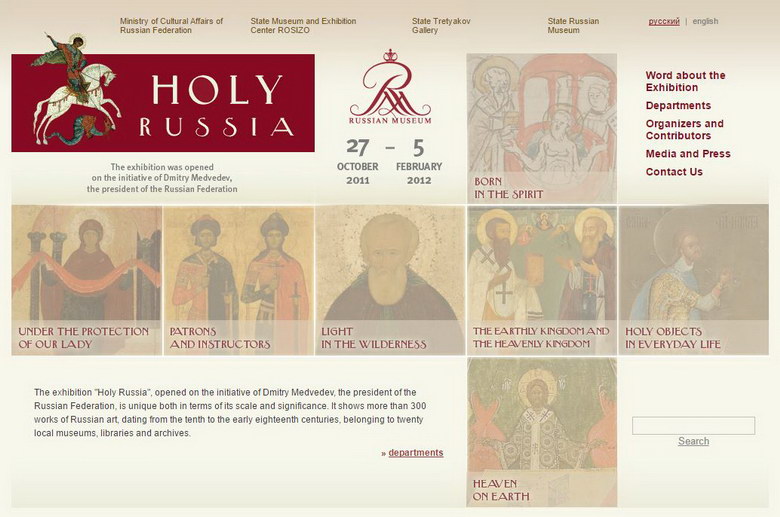Holy Russia

The exhibition "Holy Russia", opened on the initiative of Dmitry Medvedev, the president of the Russian Federation, is unique both in terms of its scale and significance. It shows more than 300 works of Russian art, dating from the tenth to the early eighteenth centuries, belonging to twenty local museums, libraries and archives.
The majority of these works were shown at the Louvre (Paris) at the exhibition "Holy Russia", set up as part of the cultural program "The Year France – Russia, 2010". Bringing together a large number of early Russian icons, illuminated books, monumental painting, pieces of silver and gold, figurative embroidery and other works, the Paris show, for the first time, gave an opportunity to the European public to fully appreciate the singular beauty of the spiritual and artistic culture of Old Rus'. The exhibition was greeted as a significant artistic and political event, becoming an important step in further bringing together Western Europe and Russia. That same year, in 2010, a decision was made to organize the "Holy Russia" exhibition at home.
It is obvious that works of early Russian art are much more well-known and accessible in this country than in the West, a fact, which, however, does not in any way diminish the role of this exhibition for the Russian public. Such a large and carefully chosen collection was never demonstrated in a particular museum, as part of a single show.
All these works are not intended just to illustrate a detailed history of Russian Medieval culture, like it was done in Paris, but are divided in accordance with those main themes, which, for the modern mentality, form the concept of "Holy Russia" as an imaginary model of an ideal social and spiritual world. This model, which began forming as early as the Middle Ages, acquired its special meaning in the 19th century, as old Russian ecclesiastical literature and art began to be appreciated and thoroughly studied. At the same time it was now clear that this heritage was particularly precious and important for the Russian people. These discoveries, in their turn, led to an emergence of a visually convincing and reliable "material" image of Old Rus' – a Christian Orthodox country, confident in its sense of piety and purity. This was a country of many people practicing asceticism and constant prayer, in which there reigned devout sovereigns, who perceived their realm as a reflection of forthcoming Heaven, a threshold leading to it. Just as any other ideal mental construction it may not reflect the full historical reality, but it still, doubtless, serves as one of the principle spiritual landmarks that allows us to comprehend the historical and cultural tradition of our fatherland.
